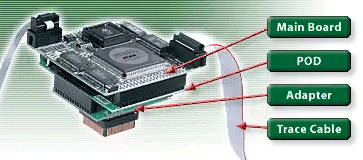This emulator model is intended to supports a few obsolete micro: NXP / Philips P89C66x, 87C552/554 and Dallas Semi DS80C320/520/530 microcontrollers only. All other 8051 MCU are supported by the Phyton PICE-52 in-circuit emulator.

The image above displays an assembled PICE-51 emulator. This is a palm-size header comprised of three stackable boards: a Main Board, POD, and Adapter (from top to bottom). The Trace Cable allows to trace external signals and output triggers.
Features Summary
- Real-time, non intrusive emulation up to 33 MHz (12-clock mode) and up to 20 MHz (6-clock mode);
- 3V to 5V 8051 derivatives are supported;
- Up to 256K bytes program memory & 256K data memory (64K & 64K by default);
- Memory mapping between the ICE and target with 256 bytes resolution;
- Up to 512K true hardware breakpoints;
- 4 complex breakpoints / triggers;
- Up to 16K frame deep by 64 bit wide trace buffer;
- 48-bit on-board timer;
- Shadow RAM provides target device RAM real-time access without disturbing emulation;
- "On-the-fly" access to the memory, breakpoints, tracer, and timer;
- Trace cable with 8 probe inputs and 1 trigger output;
- Software controllable embedded clock generator;
- Connects to a PC serial port via a light cable opto-isolated for extra protection;
- Integrated development environment Project-51 that includes an editor, a project manager, the MCA-51 assembler;
- Source level and project level support for Keil, IAR, Raisonance, Altium, Hi-Tech, Intel, Avocet, GNU and other compilers;
- PDS-52 software simulator in included to the IDE;
- Donwnload a full versions of the Project-51 IDE and MCA-51 macro assembler.
